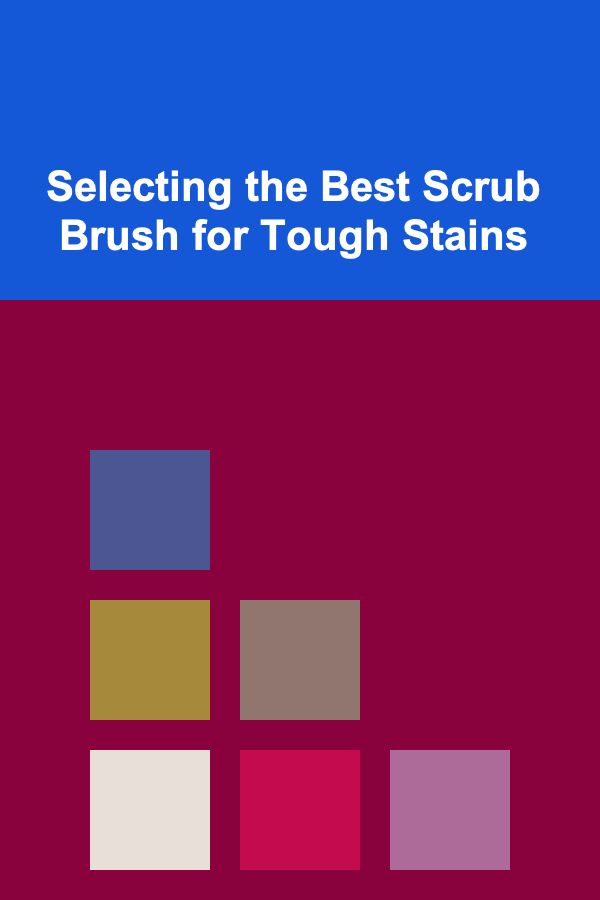
Selecting the Best Scrub Brush for Tough Stains
ebook include PDF & Audio bundle (Micro Guide)
$12.99$10.99
Limited Time Offer! Order within the next:

Tackling tough stains can be a frustrating and time-consuming chore. Whether it's baked-on grease in the kitchen, stubborn mildew in the bathroom, or ground-in dirt on outdoor surfaces, the right tools can make all the difference. Among these essential tools, the scrub brush stands out as a versatile and effective option. However, not all scrub brushes are created equal. Choosing the best scrub brush for the specific task at hand is crucial for achieving optimal results while minimizing effort and preventing damage to surfaces. This comprehensive guide will delve into the various factors to consider when selecting a scrub brush, helping you make informed decisions and conquer even the most challenging stains.
Understanding the Challenge: Types of Tough Stains
Before diving into the selection process, it's important to understand the nature of the stains you're trying to remove. Different types of stains require different approaches, and therefore, different types of scrub brushes.
Common Stain Categories:
- Grease and Oil: Found primarily in kitchens (stovetops, ovens, cookware) and garages (tools, floors). These stains are hydrophobic and require degreasing agents and brushes that can effectively dislodge the oily residue.
- Mold and Mildew: Thrive in damp environments like bathrooms, basements, and outdoor surfaces. These stains are biological and require antimicrobial cleaners and brushes that can reach into crevices.
- Rust: Often found on metal surfaces exposed to moisture. Rust stains require specialized rust removers and abrasive brushes to break down the iron oxide.
- Hard Water Stains: Common in bathrooms and kitchens, caused by mineral deposits in hard water. These stains require acidic cleaners and brushes that can effectively scrub away the mineral buildup.
- Food Stains: From spilled drinks to splattered sauces, food stains can be found throughout the home. The appropriate cleaning agent and brush will depend on the specific food and surface.
- Ground-in Dirt and Grime: Common on floors, outdoor furniture, and car interiors. These stains often require a combination of soaking, scrubbing, and appropriate cleaning solutions.
Identifying the type of stain you're dealing with will help you narrow down the types of cleaning agents and, consequently, the type of scrub brush you need.
Key Factors to Consider When Choosing a Scrub Brush
Selecting the right scrub brush involves considering several crucial factors, including bristle type, handle design, size, shape, and overall durability. Evaluating these factors will ensure you choose a brush that is effective, comfortable to use, and long-lasting.
1. Bristle Type: The Heart of the Matter
The bristle type is arguably the most important factor in determining a scrub brush's effectiveness. Bristles come in various materials, each offering different levels of stiffness and abrasion.
a. Natural Bristles:
- Pros: Generally softer and more gentle, making them suitable for delicate surfaces like painted walls, wooden furniture, and fine fabrics. They are also biodegradable, making them a more environmentally friendly option.
- Cons: Less durable than synthetic bristles, especially when exposed to water and harsh chemicals. They also tend to absorb water, which can lead to bacterial growth if not properly cleaned and dried.
- Examples: Hog bristle, horsehair.
- Best For: Light cleaning, dusting, and gentle stain removal on delicate surfaces.
b. Synthetic Bristles:
- Pros: More durable, resistant to chemicals, and less likely to harbor bacteria than natural bristles. Available in a wide range of stiffness levels, making them suitable for various cleaning tasks.
- Cons: Can be too abrasive for delicate surfaces.
- Types:
- Nylon: A versatile and durable option, suitable for general cleaning tasks. Resistant to most chemicals and abrasions. Available in varying degrees of stiffness. A good all-around choice.
- Polypropylene: More rigid than nylon and offers good resistance to chemicals and heat. Often used in brushes designed for heavy-duty cleaning and scrubbing. Excellent for grout and tough stains.
- Polyester: Resistant to water absorption and stretching. A good option for brushes that will be used frequently in wet environments.
- Tampico Fiber: A natural fiber derived from the agave plant. While natural, it's much more robust than other natural fibers and provides good scrubbing power. Biodegradable and often used in dish brushes.
- Best For: General cleaning, heavy-duty scrubbing, and stain removal on durable surfaces like tile, concrete, and metal.
c. Wire Bristles:
- Pros: Extremely abrasive and durable, making them ideal for removing rust, paint, and other stubborn deposits from metal surfaces.
- Cons: Can easily scratch and damage surfaces if not used carefully. Should only be used on appropriate materials.
- Materials: Steel, brass, stainless steel.
- Best For: Removing rust, paint, and other tough deposits from metal surfaces. Use with caution.
Bristle Stiffness: Beyond the material, bristle stiffness is a critical factor. Softer bristles are ideal for gentle cleaning and delicate surfaces, while stiffer bristles are necessary for tackling tough stains and heavily soiled areas. Consider the Mohs hardness scale of the material you are cleaning before choosing the bristle stiffness. Using a brush that is harder than the material being cleaned will cause scratches and damage.
2. Handle Design: Comfort and Control
The handle design significantly impacts the comfort and control you have while scrubbing. A comfortable and ergonomic handle can reduce fatigue and improve your cleaning efficiency.
a. Material:
- Plastic: Lightweight, durable, and easy to clean. Often molded for ergonomic grips.
- Wood: Provides a classic look and feel. Can be more comfortable for some users but requires more maintenance to prevent water damage and bacterial growth.
- Rubber or Silicone Overmold: Offers a non-slip grip, even when wet. Can improve comfort and control.
b. Shape and Size:
- Straight Handles: Simple and versatile, suitable for general cleaning tasks.
- Angled Handles: Provide better leverage and reach, making them ideal for cleaning corners and hard-to-reach areas.
- Curved Handles: Designed for ergonomic comfort and reduced strain on the wrist.
- Long Handles: Suitable for cleaning floors, walls, and other large surfaces without bending over. Can also be useful for reaching high areas.
- Short Handles: Offer greater control and maneuverability for detailed cleaning tasks.
c. Grip:
- Textured Grips: Provide a better hold, especially when hands are wet or soapy.
- Contoured Grips: Designed to fit comfortably in the hand and reduce strain.
Consider the types of tasks you'll be performing and choose a handle design that provides the best comfort, control, and reach for those tasks.
3. Brush Size and Shape: Matching the Tool to the Task
The size and shape of the scrub brush head should be appropriate for the area you're cleaning. Using a brush that's too large can be unwieldy, while a brush that's too small can make the job take longer.
a. Size:
- Small Brushes: Ideal for detailed cleaning, reaching into tight spaces, and scrubbing grout lines.
- Medium Brushes: Versatile for general cleaning tasks on various surfaces.
- Large Brushes: Best for cleaning large areas like floors, walls, and patios.
b. Shape:
- Rectangular/Square Brushes: Good for general cleaning and covering large areas.
- Round Brushes: Ideal for cleaning curved surfaces and reaching into corners.
- Angled Brushes: Designed for cleaning corners and edges.
- Detail Brushes (e.g., toothbrush-style): Perfect for precision cleaning and reaching into very small spaces.
Consider the size and shape of the areas you'll be cleaning most frequently and choose brushes that are appropriately sized and shaped for those tasks.
4. Durability and Build Quality: Investing in Longevity
A well-made scrub brush will withstand repeated use and exposure to harsh chemicals. Investing in a durable brush will save you money in the long run by reducing the need for frequent replacements.
- Bristle Attachment: Look for brushes with securely attached bristles that are unlikely to fall out with use. Check for signs of weak glue or loose bristle clumps.
- Handle Construction: Ensure the handle is sturdy and well-connected to the brush head. Avoid brushes with flimsy handles that are prone to breaking.
- Material Quality: Choose brushes made from high-quality materials that are resistant to cracking, warping, and degradation.
Read reviews and look for brands known for producing durable and long-lasting scrub brushes. Consider the intended use and choose a brush that is designed to withstand the rigors of that task.
Specific Scrub Brush Types and Their Applications
Now that we've covered the key factors to consider, let's explore some specific types of scrub brushes and their ideal applications.
1. Grout Brushes: The Grout-Busting Experts
Grout lines are notorious for trapping dirt, grime, and mold. Grout brushes are specifically designed to tackle this challenge. These brushes typically feature a narrow, angled head with stiff bristles that can effectively scrub away buildup from between tiles.
- Features: Narrow head, stiff nylon or polypropylene bristles, angled design for reaching into grout lines.
- Ideal For: Cleaning grout in bathrooms, kitchens, and other tiled areas.
- Tips: Use with a grout cleaner or a mixture of baking soda and water. Scrub in a back-and-forth motion, following the grout lines.
2. Deck Brushes: Taming Outdoor Surfaces
Deck brushes are designed for cleaning large outdoor surfaces like decks, patios, and sidewalks. These brushes typically have a wide head with stiff bristles and a long handle for comfortable cleaning without bending over.
- Features: Wide head, stiff synthetic bristles (often polypropylene or a blend), long handle (often telescopic), some models may include a squeegee.
- Ideal For: Cleaning decks, patios, sidewalks, and other large outdoor surfaces.
- Tips: Use with a deck cleaner or a pressure washer. Scrub in overlapping strokes, working in sections.
3. Toilet Bowl Brushes: Maintaining Hygiene
Toilet bowl brushes are essential for maintaining a clean and hygienic bathroom. These brushes typically have a long handle and a round or angled head designed to reach all areas of the toilet bowl.
- Features: Long handle, round or angled head, stiff synthetic bristles (often nylon), often includes a holder for storage.
- Ideal For: Cleaning toilet bowls and removing stains and deposits.
- Tips: Use with a toilet bowl cleaner. Scrub thoroughly, paying attention to the rim and the bottom of the bowl. Rinse the brush after each use and store it in the holder.
4. Kitchen Scrub Brushes: Conquering Kitchen Clutter
Kitchen scrub brushes are designed for a variety of cleaning tasks in the kitchen, from scrubbing pots and pans to cleaning countertops and sinks. These brushes come in various shapes and sizes, with different bristle types to suit different cleaning needs.
- Features: Variable shapes and sizes, various bristle types (nylon, polypropylene, tampico fiber), some models include a scraper for removing baked-on food.
- Ideal For: Cleaning pots, pans, countertops, sinks, and other kitchen surfaces.
- Tips: Choose a brush with bristles that are appropriate for the surface you're cleaning. Use with dish soap or a kitchen cleaner. Rinse the brush after each use and allow it to air dry.
5. Handheld Scrub Brushes: Versatile Cleaning Companions
Handheld scrub brushes are versatile tools for a wide range of cleaning tasks throughout the home. These brushes typically have a compact size and a comfortable handle for easy maneuverability.
- Features: Compact size, comfortable handle, various bristle types (nylon, polypropylene, natural bristles), often feature a curved or ergonomic design.
- Ideal For: General cleaning tasks, scrubbing sinks, bathtubs, showers, and other surfaces.
- Tips: Choose a brush with bristles that are appropriate for the surface you're cleaning. Use with a general-purpose cleaner or a specialized cleaner for the specific task. Rinse the brush after each use and allow it to air dry.
6. Drill Brush Attachments: Powering Through Tough Jobs
Drill brush attachments are designed to be used with a power drill to provide extra scrubbing power for tackling tough stains and large areas. These attachments come in various shapes and sizes, with different bristle types to suit different cleaning needs.
- Features: Various shapes and sizes (flat, round, conical), various bristle types (nylon, polypropylene), designed to attach to a standard power drill.
- Ideal For: Cleaning large areas, scrubbing tile, grout, carpets, and other surfaces. Excellent for tough stains on durable surfaces.
- Tips: Use with caution to avoid damaging surfaces. Start with a low drill speed and increase as needed. Wear safety glasses to protect your eyes. Always test in an inconspicuous area first.
Maintaining Your Scrub Brush: Ensuring Longevity and Hygiene
Properly maintaining your scrub brush will extend its lifespan and prevent the growth of bacteria and mold.
- Rinse Thoroughly After Each Use: Remove all traces of soap, cleaner, and debris from the bristles.
- Air Dry Completely: Store the brush in a well-ventilated area to allow it to dry completely. Avoid storing it in a damp environment, as this can promote bacterial growth. Hang the brush if possible to improve airflow.
- Clean Periodically with Disinfectant: Soak the brush in a solution of bleach and water or a disinfectant cleaner to kill bacteria and mold.
- Replace When Worn: Replace the brush when the bristles become frayed, worn, or discolored. A worn-out brush will not clean as effectively and can harbor bacteria.
Troubleshooting Common Scrub Brush Problems
Even with proper care, you may encounter some common problems with your scrub brushes. Here's how to troubleshoot them:
- Bristles Falling Out: This can be caused by weak glue or excessive wear. If the brush is relatively new, consider contacting the manufacturer for a replacement. If the brush is old, it's probably time to replace it.
- Bristles Bending or Matting: This can be caused by using the brush on surfaces that are too abrasive or by storing the brush improperly. Try straightening the bristles with your fingers or by soaking the brush in hot water. To prevent this, choose a brush with appropriate bristle stiffness for the task at hand and store the brush in a way that prevents the bristles from being compressed.
- Brush Smells Musty: This indicates bacterial or mold growth. Clean the brush thoroughly with a disinfectant solution and allow it to dry completely. Ensure proper ventilation to prevent future growth.
- Difficulty Removing Stains: This could indicate that the brush is not the right type for the stain, or that the cleaning solution is not effective. Try using a different brush or a stronger cleaning solution. Also, consider pre-soaking the stained area before scrubbing.
Conclusion: Choosing the Right Brush for Stain-Busting Success
Selecting the best scrub brush for tough stains is a crucial step in achieving a clean and healthy home. By considering the type of stain, the surface you're cleaning, the bristle type, the handle design, the brush size and shape, and the overall durability of the brush, you can make an informed decision and choose the perfect tool for the job. Remember to maintain your scrub brushes properly to extend their lifespan and prevent the growth of bacteria. With the right scrub brush in hand, you'll be well-equipped to tackle even the most challenging stains and keep your home sparkling clean.
Reading More From Our Other Websites
- [Home Cleaning 101] How to Identify and Remove Common Stains with Homemade Cleaning Solutions: A Natural Approach to Spotless Surfaces
- [Personal Financial Planning 101] How to Finance Your Small Business: Alternatives to Traditional Bank Loans
- [Mindful Eating Tip 101] Best Ways to Use Mindful Eating to Manage Stress‑Induced Cravings During Busy Seasons
- [Home Storage Solution 101] How to Create a Clutter-Free Home Office with Effective Storage Solutions
- [Simple Life Tip 101] Best Simple‑Life Morning Journaling Prompts for Clarity and Calm
- [Organization Tip 101] How to Organize Tech Gear in a Compact Workstation
- [Organization Tip 101] How to Set Up a Morning Routine to Start the Day Organized
- [Home Security 101] How to Use Smart Locks to Improve Home Security
- [Home Lighting 101] How to Use Lighting to Highlight Artwork and Decor
- [Personal Care Tips 101] How to Layer Makeup Primer with Other Skincare Products

How to Build an Emergency Fund Without Sacrificing Your Lifestyle
Read More
How to Declutter Your Kitchen Countertops for a Clean Look
Read More
How to Set Up a DIY Cocktail Bar for Your Guests
Read More
How to Use Blogging to Drive Traffic to Your Dropshipping Business
Read More
How to Use Mind Mapping for Activity Planning
Read More
Mastering the Art of Iced Coffee Drinks
Read MoreOther Products

How to Build an Emergency Fund Without Sacrificing Your Lifestyle
Read More
How to Declutter Your Kitchen Countertops for a Clean Look
Read More
How to Set Up a DIY Cocktail Bar for Your Guests
Read More
How to Use Blogging to Drive Traffic to Your Dropshipping Business
Read More
How to Use Mind Mapping for Activity Planning
Read More